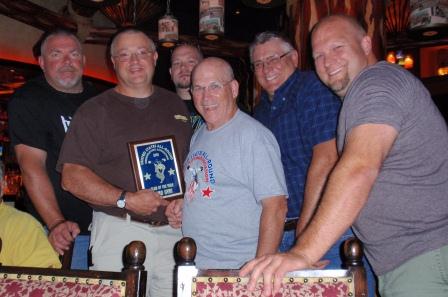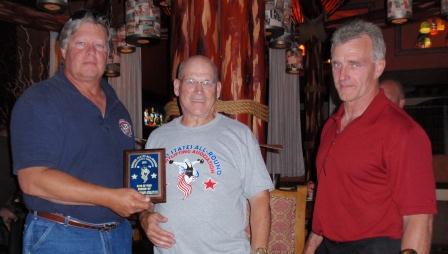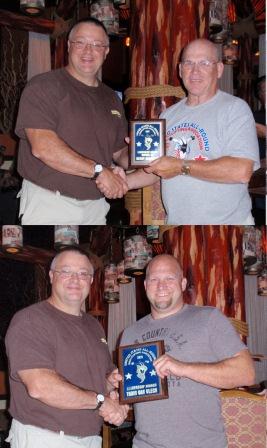by Al Myers
Another new rule that was passed at the USAWA National Meeting was a policy outlining repetition records. Up till now, nothing was in place for this as a way of keeping track of these type of records. Our USAWA rules have always stated that any official lift may be done for repetition, but a method for keeping track of these records was not defined. The IAWA President Steve Gardner and I discussed this in length at the Worlds in Australia, and after several nights of “brainstorming” we can up with a good plan. Included in this discussion was USAWA Prez Denny Habecker, Mark Haydock, Chad Ullom, and Art Montini. So I feel that some of the greatest minds in the all-round lifting World was at work in coming up with this plan to deal with repetition records (I just took notes by the way…).
First, I want to outline some basic rules that have been in place in the Rule Book for repetition records to give you a baseline:
K. Repetition Lifts
Any approved lift may be done for repetitions, provided it is done according to the rules of the individual lift. Repetition lifts are allowed to be a part of any USAWA competition.
That’s it!!! I’ve always seen how a “big problem” could arise if lifters actually got serious about establishing repetition records with this minimal rule. Let me give this example:
Lifter A: Weighs 190# and is 25
Performs a lift of 200 pounds for 9 repetitions
Lifter B: Weighs 194# and is 33
Performs the same lift with 210 pounds for 8 repetitions
Which one should be the repetition record holder in the 90 Kilogram class??? Lifter A did more total reps, but lifter B used more weight on his lifts. Obviously some formula should be used to determine who gets “the spot” in the record list, because if you didn’t, you might as well list ANY repetition lift for record that is done, because of the infinite number of possibilities of choosing rep schemes with different poundages.
Next I want to make a few comments (ok, my opinions) on how the IAWA deals with repetition records. In the IAWA rulebook there are only 8 lifts that can be officially done for IAWA repetition records. These are: Repetition Cleans with Bodyweight, Repetition Presses with Bodyweight, Repetition Snatches with Bodyweight, Repetition Clean and Jerks with Bodyweight, Repetition Jerks with Bodyweight, Repetition Deadlifts with Bodyweight, Abdominal Raise for reps, Roman Chair Sit Up for repetitions. That’s the list – so you can see that the IAWA does NOT allow other official lifts to done for World Records. The first 6 lifts tell the amount of weight that must be used (bodyweight), but the last two do not specify anything (so it’s open-ended, with endless possibilities like the USAWA). I can understand bodyweight deadlifts for repetition, but bodyweight snatches??? REALLY??? That’s most lifters goal for 1 rep in the USAWA/IAWA. Obviously, there was not much thought put into the IAWA system for repetition records (my opinion), and is only a slightly better system than what the USAWA has (which is NOTHING, another opinion).
Now for the answer to “all this mess”. This was the rule passed at the 2012 USAWA National Meeting to handle repetition records from now on:
Rule V. Records: Records for repetition records will be kept for each official lift within the same weight classes and age groupings as individual records. The method for keeping these records will be based on the bodyweight-corrected Lynch Points of the total weight lifted (reps times weight lifted), with the Lynch Points being used as the repetition record. This will allow the lifter to choose whatever weight and repetition scheme they desire in order to establish or set a repetition record. The same weight must be used for each repetition. There must not be any long pauses between repetition lifts, with this being based on the judgement of the official. The rules of the individual lifts apply, including the officials commands on each repetition.
It’s amazing all this can be resolved with one simple paragraph in the Rule Book. This rule will be proposed at the IAWA World Meeting in October, so hopefully, the IAWA and the USAWA can be “on the same page” with this issue. Now for the answer of who has the repetition record in the prior example:
Lifter A: (200#) x (9 reps) x (.9199 Lynch Factor) = 1655.82 Lynch Points
Lifter B: (210#) x (8 reps) x (.9091 Lynch Factor) = 1527.29 Lynch Points
Lifter A gets the repetition record in the 90 KG weight class!!!!! This method allows a lifter to make “the choice” of what weight and rep scheme they want to use – thus require a little strategy. Each lift is different in the number of reps that can “comfortably” be done with more weight, and this decision is now left up to the lifter doing the repetitions.
I listed the lifters age just to confuse you. Age should not matter as all age groups should be represented in the repetition record list just like the individual record list, and the team record list. Records have never been age-adjusted, and they shouldn’t be. I believe that the record list for repetition records should be a separate listing due to the uniqueness of it (just like with the team record list). However, it will look EXACTLY like the individual record list in age categories and bodyweight divisions. You may also notice that the rule calls for the lift to be done with the EXACT same rules as listed for the individual lift, including officials commands like the down command. That’s the way it should be done – the right way!


